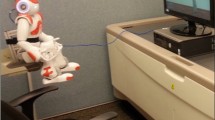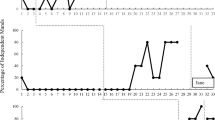Abstract
Thirty-four children, with autism spectrum disorders, ages 4–14 years, were matched and randomly assigned to one of two conditions for learning a novel juice-making task and producing two novel words about the event. Seventeen sighted children were manually guided to perform the task and tactually prompted during imitated productions of novel words for the event. Their matched controls heard the novel words and watched the juice-making task being performed. Performances on four verbal and two nonverbal measures right after instruction and at 24–48 h post-instruction, revealed higher scores for the “hands-on”, participation than observation group on both verbal and nonverbal tasks. This study offers a paradigm for exploring the instructional advantage of enhanced participatory experience.




Similar content being viewed by others
References
Affolter, F. (1991). Perception, interaction and language (originally published in German by Neckar Verlag). New York: Springer.
Affolter, F., & Bischofberger, W. (2000). Nonverbal perceptual and cognitive processes in children with language disorders: Toward a new framework for clinical intervention. Mahwah, NJ: Erlbaum.
American Psychiatric Association. (1994). Diagnostic and statistical manual of mental disorders (4th ed.). Washington, DC: American Psychiatric Association.
Bara, F., Gentaz, E., & Cole, P. (2004). The visuo-haptic and haptic exploration of letters increase kindergarten children’s reading acquisition. Cognitive development, 19, 433–499.
Baranek, G. T. (2002). Efficacy of sensory and motor interventions for children with autism. Journal of Autism and Developmental Disorders, 32(5), 397–422.
Bloom, L., & Tinker, E. (2001). The intentionality model and language acquisition: Engagement, effort, and the essential tension in development. Monographs of the Society for Research in Child Development, 66, 1–91.
Brownell, R. (2000a). Expressive one-word picture vocabulary test (3rd ed.). Novato, CA: Academic Therapy Publications.
Brownell, R. (2000b). Receptive one-word picture vocabulary test (2nd ed.). Novato, CA: Academic Therapy Publications.
Childers, J. B., & Tomasello, M. (2006). Are nouns easier to learn than verbs? Three experimental studies. In K. Hirsh-Pasek & R. M. Golinkoff (Eds.), Action meets word: How children learn verbs (pp. 331–335). NY: Oxford University Press.
Craddock, M., Martinovic, J., & Lawson, R. (2011). An advantage for active versus passive aperture-viewing in visual object recognition. Perception, 40, 1154–1163.
Dijkerman, H. C., & de Haan, E. H. F. (2006). Somatosensory processes subserving perception and action. Behavioral and Brain Sciences, 30, 189–239.
Dunn, L., & Dunn, L. (1997). Peabody picture vocabulary test-III. Circle Pine, MN: American Guidance Service.
Elliot, C. D. (2007). Differential Abilities Scales-II. San Antonio, TX: The Psychological Corporation.
Fisher, A., Murray, E., & Bundy, A. (1991). Sensory integration: Theory and practice. Philadelphia, PA: F. A. Davis.
Frith, U., & Happe, F. (1994). Beyond “theory of mind”. Cognition, 50, 115–132.
Gantz, M. (2006). The costs of autism. In S. O. Moldin & J. L. R. Rubenstein (Eds.), Understanding autism: From basic neuroscience to treatment. Boca Raton, FL: CRC Press.
Glenberg, A. M., Gutierrez, T., Levin, J. R., Japuntich, S., & Kaschak, M. P. (2004). Activity and imagined activity can enhance young children’s reading comprehension. Journal of Educational Psychology, 96, 424–436.
Glenberg, A. M., & Kaschak, M. P. (2002). Grounding language in action. Psychonomic Bulletin & Review, 9(3), 558–565.
Hammill, D., & Newcomer, P. (1997). Test of language development-revised. San Antonio, TX: The Psychological Corporation.
Hayden, D. (2003). Introduction to the PROMPT technique. Santa Fe, NM: PROMPT Institute Inc.
Hayden, D. (2006). The PROMPT model: Use and application for children with mixed phonological—motor impairment. Advances in Speech-Language Pathology, 8(3), 265–281.
Hoehn, T. P., & Baumeister, A. A. (1994). A critique of the application of sensory integration therapy to children with learning disabilities. Journal of Learning Disabilities, 27(6), 338–350.
James, K. H., Humphrey, G. K., Villis, T., Corrie, B., Baddour, R., & Goodale, M. A. (2002). “Active” and “Passive”learning of three-dimensional object structure within an immersive virtual reality environment. Behavioral Research Methods and Instrumental Computation, 34(3), 383–390.
Jasmin, E., Couture, M., McKinley, P., Reid, G., Fombonne, E., & Gisel, E. (2009). Sensorimotor and daily living skills of preschool children with autism spectrum disorders. Journal of Autism and Developmental Disorders, 39, 231–241.
Jonides, J., Schumacher, E. H., Smith, E. E., Koeppe, R. A., Awh, E., Reuter-Lorenz, P. A., et al. (1998). The role of parietal cortex in verbal working memory. Journal of Neuroscience, 18(13), 5026–5034.
Kaufman, A. S., & Kaufman, N. L. (1983). Kaufman assessment battery for children. Circle Pines, MN: American Guidance Service.
Klatzky, R. L., Lederman, S., & Reed, C. (1987). There’s more to touch than meets the eye: The salience of object attributes for haptics with and without vision. Journal of Experimental Psychology: General, 116(4), 356–369.
Ladefoged, P. (2001). Vowels and consonants: An introduction to the sounds of languages. Malden, MA: Blackwell Publishers Inc.
Lederman, S. J., & Klatzky, R. L. (1987). Hand movements: A window into haptic object recognition. Cognitive Psychology, 1, 342–368.
Liu, C. H., Ward, J., & Markall, H. (2007). The role of active exploration of 3D face stimuli on recognition memory of facial information. Journal of Experimental Psychology: Human Perception and Performance, 33(4), 895–904.
Minogue, J., & Jones, M. G. (2006). Haptics in education: Exploring an untapped sensory modality. Review of Educational Research, 76(3), 317–348.
Mogford, K., & Bishop, D. (1993). Five questions about language acquisition considered in the light of exceptional circumstances. In K. Mogford & D. Bishop (Eds.), Language development in exceptional circumstances (pp. 239–260). Hillsdale, NJ: Erlbaum.
Nelson, K. (1986). Event knowledge: Structure and function in development. Hillsdale, NJ: Erlbaum.
Newborg, J. (2004). Battelle developmental inventory (2nd ed.). Itasca, IL: Riverside.
Noë, A. (2004). Action in perception. Cambridge: The MIT Press.
O’Neill, M., & Jones, R. (1997). Sensory-perceptual abnormalities in autism: A case for more research. Journal of Autism and Developmental Disorders, 27, 283–293.
Pan, C.-Y. (2008). Objectively measured physical activity between children with autism spectrum disorders and children without disabilities during inclusive recess settings in Taiwan. Journal of Autism and Developmental Disorders, 38, 1292–1301.
Pfeifer, R., & Bongard, J. (2007). How the body shapes the way we think. Cambridge: MIT Press.
Rogers, S. J., Hayden, D., Hepburn, S., Charlifue-Smith, R., Hall, T., & Hayes, A. (2006). Teaching young nonverbal children with autism useful speech: A pilot study of the Denver Model and PROMPT interventions. Journal of Autism and Developmental Disorders, 36(8), 1007–1024.
Rogers, S. J., & Ozonoff, S. (2005). Annotation: What do we know about sensory dysfunction in autism? A critical review of the empirical evidence (2005). Journal of Child Psychology and Psychiatry, 46(2), 1255–1268.
Rossetti, L. (1990). The Rossetti Infant-Toddler Language Scale. East Moline, IL: Lingui Systems Inc.
Semel, E., Wiig, E. H., & Secord, W. A. (1987). Clinical evaluation of language fundamentals (2nd ed.). San Antonio, TX: The Psychological Corporation.
Siaperas, P., Ring, H. A., McAllister, C. J., Henderson, S., Barnett, A., Watson, P., et al. (2012). Atypical movement performance and sensory integration in Asperger’s Syndrome. Journal of Autism and Developmental Disorders, 42, 718–725.
Smit, A. B., Hand, L., Freilinger, F. F., Bernthal, J. E., & Bird, A. (1990). The Iowa articulation norms project and its Nebraska replication. Journal of Speech and Hearing Disorders, 55, 779–798.
St. Louis, K., & Ruscello, D. (1987). Oral speech mechanism screening examination (2nd ed.). Austin, TX: Pro-Ed.
Stockman, I. J. (2000). Epilogue: Language learning and nonverbal interaction in daily events. In F. Affolter & W. Bischofberger (Eds.), Nonverbal perceptual and cognitive processes in children with language disorders (pp. 197–250). Mahwah, NJ: Erlbaum.
Stockman, I. J. (2004). Movement and action in learning and development: Clinical implications for pervasive developmental disorders. San Diego, CA: Elsevier/Academic Press.
Thelen, E. (1995). Motor development: A new synthesis. American Psychology, 50(2), 79–95.
Thelen, E., & Smith, L. B. (1994). A dynamic systems approach to the development of cognition and action. Cambridge, MA: MIT Press.
Thorndike, R., Hagen, E., & Sattler, J. (1986). Stanford-Binet Intelligence Scale (4th ed.). Chicago, IL: Riverside.
Tomasello, M. (1995). Beyond names for things: Young children’s acquisition of verbs. Hillsdale, NJ: Erlbaum.
Waterhouse, L., Fein, D., & Modahl, C. (1996). Neurofunctional mechanisms in autism. Psychological Review, 103, 457–489.
Wechsler, D. (1991). Wechsler intelligence scale for children-iII. San Antonio, TX: The Psychological Corporation.
Wiggins, L. D., Robins, D. L., Bakeman, R., & Adamson, L. B. (2009). Brief Report: Sensory abnormalities as distinguishing symptoms of autism spectrum disorders in young children. Journal of Autism and Developmental Disorders, 39, 1087–1091.
Wilson, M. (2002). Six views of embodied cognition. Psychonomic Bulletin & Review, 9(4), 625–636.
Acknowledgments
This study was supported by a Dissertation Completion Grant from the College of Communication Arts and Sciences at Michigan State University. The authors are indebted to the professionals (teachers, speech-language pathologists, administrators and staff) and to the families and their children with autism in Berrien County, Michigan and to the professionals and students who helped with this research at Michigan State University.
Author information
Authors and Affiliations
Corresponding author
Rights and permissions
About this article
Cite this article
Latham, S.O., Stockman, I.J. Effect of Augmented Sensorimotor Input on Learning Verbal and Nonverbal Tasks Among Children with Autism Spectrum Disorders. J Autism Dev Disord 44, 1288–1302 (2014). https://doi.org/10.1007/s10803-013-1990-9
Published:
Issue Date:
DOI: https://doi.org/10.1007/s10803-013-1990-9




